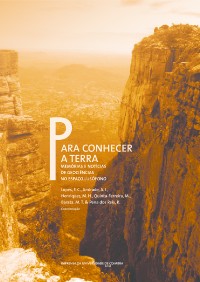Please use this identifier to cite or link to this item:
https://hdl.handle.net/10316.2/31484| Title: | Caracterização das feições geomorfológicas da paisagem da Serra do Tepequém (Norte de Roraima, Brasil) | Other Titles: | Characterization of the landscape geomorphological features of the tepequém mountain (North Roraima, Brazil) | Authors: | Neta, L. C. Beserra Nascimento, F. A. Júnior, S. S. Tavares |
Keywords: | Morphostructures;Photointerpretation;Tepequém Mountain;North Roraima (Brazil);Morfoestruturas;Fotointerpretação;Serra do Tepequém;Norte de Roraima (Brasil) | Issue Date: | 2012 | Publisher: | Centro de Estudos Clássicos e Humanísticos da Universidade de Coimbra | Journal: | http://hdl.handle.net/10316.2/24406 | Abstract: | The landscapes of the northern Roraima state represent a unique view in the
Brazilian Amazon. In this scenario stand out tableland that can reach about 2.800 m altitudes
known regionally by tepuis, like the example of Mount Roraima. These reliefs are
made in the Roraima Supergroup sedimentary rocks, of Paleoproterozoic age. The Tepequém
Mountain (object of study) is referred in the literature as a tabular structure with maximum
altitudes of up to 1.100 meters. The study is based on the morphostructural features mapping
through photointerpretatives techniques in remote sensing images in order to characterize the
geomorphological features modeling the landscape of the mountain Tepequém. The applied
procedures included mono and stereoscopic analysis for the recognition of natural elements
(relief and drain), through the textural properties characterization. The textural elements were
integrated using the techniques of digital image processing and have generated products such as
morphostructural and relief maps, combined with the Numerical Model of Terrain (NMT)
on the altitude and slope aspects. These products confirm the occurrence of various forms of
relief at the top of the Tepequém Mountain, with a gap of up to 500 m, mischaracterizing the
morphology of this type of tabular relief As paisagens do norte do Estado de Roraima constituem um panorama único na Amazônia brasileira. Neste cenário se destacam relevos tabulares, que podem atingir cerca de 2.800 m de altitudes, conhecidos regionalmente por tepuis, a exemplo do Monte Roraima. Estes relevos são elaborados em rochas sedimentares do Supergrupo Roraima, de idade Paleoproterozóica. A serra do Tepequém (objeto de estudo) é referenciada, na literatura atual, como uma estrutura tabular com altitudes máximas de até 1.100 metros. O estudo se fundamenta no mapeamento de feições morfoestruturais, através de técnicas fotointerpretativas em imagens de sensores remotos, a fim de melhor caracterizar as feições geomorfológicas, que formam a paisagem da serra do Tepequém. Os procedimentos aplicados foram análises mono e estereoscópica, para o reconhecimento de elementos naturais (relevo e drenagem), através da caracterização das propriedades texturais. Os elementos texturais foram integrados via técnicas de processamento de imagens digitais e geraram produtos como os mapas morfoestruturais e de relevo combinados com Modelo Numérico de Terreno (MNT), referente à altimetria e inclinação de vertentes. Estes produtos confirmam a ocorrência de variadas formas de relevo no topo da serra do Tepequém, com um desnível altimétrico de até 500 m, que descaracterizam a morfologia desta qualidade de relevo tabular |
URI: | https://hdl.handle.net/10316.2/31484 | ISBN: | 978-989-26-0534-0 (PDF) | DOI: | 10.14195/978-989-26-0534-0_44 | Rights: | open access |
| Appears in Collections: | Para conhecer a Terra: memórias e notícias de Geociências no espaço lusófono |
Files in This Item:
| File | Description | Size | Format | |
|---|---|---|---|---|
| 44-para_conhecer_a_terra_artigo.pdf | 1.37 MB | Adobe PDF |  |
Items in DSpace are protected by copyright, with all rights reserved, unless otherwise indicated.
